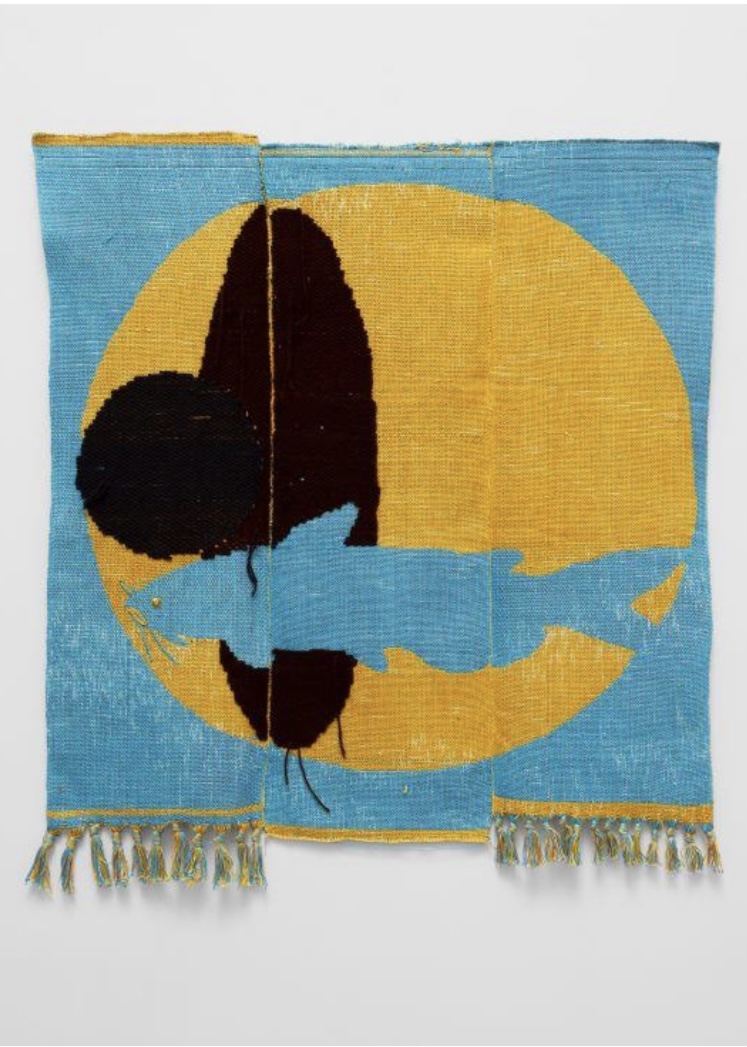
Diedrick Brackens: heaven is a muddy riverbed
5814 Wilshire Boulevard, Los Angeles, CA 90036
Saturday, January 29 at 6:00 PM – 9:00 PM
Ends May 8, 2022
Ends May 8, 2022
Craft Contemporary presents heaven is a muddy riverbed, artist Diedrick Brackens’ first survey on the West Coast and the first exhibition to look at his poetry in depth. Known primarily for his narrative, figurative, tapestry weavings that reference real life events and allegories, this exhibition is an intimate examination of the catfish in Brackens’ weavings and poetry. An accompanying publication documents all of Brackens’ catfish-themed weavings and poems to date.
fish prayers are easy to answer
and the days pass quiet, so i sleep.
sometimes, i dream of boys. they fall
and flap, breaking open my glassy eye.
they dance down, deep into my belly
where i can't cry them out. i try
and fill their chests with; “breathe! god! brother!”
i don’t know the words for save or swim.
my catfish wreath them—suits of clouds.
This is last stanza of Diedrick Brackens’ poem, “they have grown gills.” Brackens wrote the poem for Steven Booker, Carl Baker, and Anthony Freeman – three young Black men who drowned while in police custody outside Brackens’ hometown of Mexia, Texas in 1981. The young men were arrested during a Juneteenth celebration, handcuffed, and transported across Lake Mexia when the police boat capsized, sending them to their deaths. Although the young men died eight years before his birth, their deaths have had a lasting impact on Brackens and the community in Mexia. In numerous weavings and poems, Brackens renders the three boys as catfish, resurrected to live eternally in the waters.
Since Brackens first introduced the catfish into his work in 2017, it has become an enduring, multi-dimensional motif. Early weavings, such as the exhibition’s namesake heaven is a muddy riverbed (2018), memorialize the three men who drowned in Lake Mexia. Born of the land and water and rendered in the same subtle blues, the three catfish now exist outside of these earthly constraints. They occupy a space that is yet to be illustrated, full of possibility. Brackens creates a limitless world for these young men and other Black Americans, one that is denied by the white supremacy that continues to shape political, carceral, and cultural structures in the United States.
Over time, Brackens’ color palettes intensified, his weavings grew larger in scale, and he introduced the human form as silhouette, drawing upon his own body as a reference. In works such as immersion circle (2019) and there is a leak (2020), the silhouettes live in the same worlds as the catfish, imparting additional narratives of male relationships into the work – whether those be family, lovers, companions, or the self. In these compositions, the catfish’s presence becomes more fluid. It may be protector or prey, a sacred presence, a guide. Catfish still dart through the water, but, at times, they are held by the human figure or fully merge with it. This merging of the catfish and human form becomes even more evident in mud bright sight and water and dreams (both 2021), two of Brackens’ new works for the exhibition. In these pieces, land, water, and human form become layered abstract shapes that fuse into a pond, home to a solitary catfish.
Along with the production of his textile works, Brackens has long been interested in language and started taking poetry classes and writing about four years ago. As he further describes in a recent interview in Gulf Coast Journal: A Journal of Literature and Fine Arts, “Narrative and language are so tied up in the medium I have chosen in weaving. I have always been interested in the written word, particularly poetry. The language around text/textile share etymological roots in ‘texere’ (to weave) and thinking about the word poem and its Greek root ‘poiein’ (meaning to create) it makes sense to align my work with words and that my weavings, through image and materials, must tell a story.”
In Brackens’ poetry, the catfish transforms from visual motif to metaphor, further demonstrating the richness of meaning and deep significance it holds throughout his creative practice. Catfish are often maligned as bottom feeders, shape shifters, and easy to catch. Yet catfish are incredibly adaptable – they currently inhabit every continent except Antarctica and some varieties can even live in salt water. Through seeing this often-reviled creature fully, caring for it, exalting its strengths, Brackens offers alternative narratives encouraging viewers to see the catfish, and other creatures that society easily dismisses, as complex, complete beings. When one’s imagination is opened to those possibilities, heaven can exist anywhere, even in the depths of a muddy riverbed.
A reading area with books selected by Brackens will also be included in the exhibition space, offering visitors an additional opportunity to learn about the many influences on his work.
- 👀Must see
